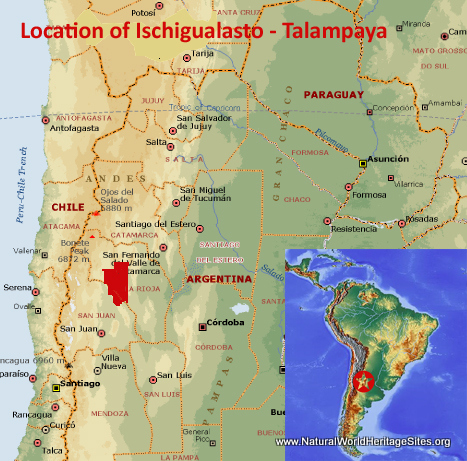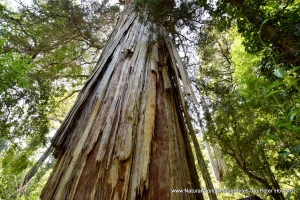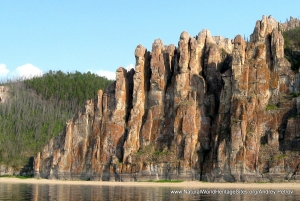EXPLORE Ischigualasto/Talampaya Natural Parks with this slideshow, check the location map and get all the facts and information below.
For slideshow description see right or scroll down (mobile). Click to view slideshow
Location and Values: The Ischigualasto/Talampaya Natural Parks are located in central Argentina, in a region of warm scrub desert that lies in the rain-shadow of the Eastern Andean foothills. The two parks form a contiguous protected area straddling the border between Rioja and San Juan Provinces, and extending over most of the Ischigualasto-Villa Union sedimentary basin. This geological basin provides the world’s most complete continental fossil record of the Triassic Period, at the dawn of the ‘Age of Dinosaurs’, 250-200 million years ago.
The dramatic natural landscape of the site exposes six geological formations that contain an exceptionally complete record and sequence of animal and plant life over this critical period of Earth’s history from the time the first ancestors of mammals appeared (in the early Triassic) to the beginning of the period of dinosaur dominance. This fossil record informs our understanding of the evolution of vertebrates and the nature of Palaeo-environments over a period of almost 50 million years. Of particular importance is the extraordinary diversity of vertebrate fossils found here, covering 56 genera of fish, amphibians, mammal-like ancestors and reptiles, including the early dinosaur, Euraptor.
Conservation Status and Prospects. According to IUCN’s Conservation Outlook Assessment (2017) the conservation status of the Ischigualasto/Talampaya Natural Parks is ‘good’. The IUCN report notes that the outstanding geological values of the site (i.e. the complete sequence of fossil-bearing sediments covering 50 million years of the Triassic Period) are well protected. However, the report also notes that other values of the site are threatened by poaching, firewood harvesting, invasive and feral species, as well as road construction impacts. According to the IUCN report, management capacity is limited, and more needs to be done to improve visitor management, enhance law enforcement capacity and harmonize approaches between the two adjoining protected areas.
Links:
Google Earth
IUCN Conservation Outlook
Official UNESCO Site Details
UNEP-WCMC Site Description
Birdlife IBA
Slideshow description
Slideshow Description: The slideshow ‘tells the story’ of the Ischigualasto/Talampaya Natural Parks with a portfolio of photos by Peter Howard from a visit in January 2020. It illustrates the landscape and geological features of this outstanding place, together with museum specimens of some of the most significant fossils and replicas of many of the animals that lived in the area during the Triassic. After an initial introductory trio of photos the slideshow begins in Ischigualasto Provincial Park, where the western boundary is marked with a full-size replica of one of the dinosaurs that frequented this place, impressively set in the arid present-day landscape. Access to both parks is strictly regulated and although visitors can enjoy the wonderful semi-desert scenery and geological features, there is no public access to any of the fossil sites. Some visitors are likely to find it frustrating to visit such an iconic fossil site without seeing any real fossils ‘on location’. Nevertheless, there are some impressive museum exhibits and open-air displays featuring replicas of some of the most significant fossil fauna.
Visitors to Ischigualasto are able to follow a 40 km-long circular route through the so-called ‘Valley of the Moon’ in a guided convoy of private vehicles that (depending on demand) leaves every hour throughout the day. The slideshow features the five points of interest around this circuit, where visitors are allowed to get out of their cars and follow short boardwalks to designated view sites. These sites (in order of appearance) have been popularly named as (1) the Painted Valley, (2) Ball’s Field, (3) The Submarine (a rock-tower feature), (4) William Sill Site Museum and (5) The Mushroom (another impressive rock-tower). Drivers are able to return to the park headquarters in a slightly looser convoy, perhaps stopping briefly to take photos of the massive red cliffs and coloured grey strata below. At the park headquarters there is a very informative museum with complete (replica) skeletons and reproductions of some of the key species, reconstructed from fossils found at the site. In addition the small William Sill Site Museum (on the Valley of the Moon circuit) illustrates what an ‘in situ’ assemblage of fossils exposed in a natural rock stratum would be like.
The second part of the slideshow features Talampaya National Park. At the park entrance there is an outdoor exhibit with life-size replicas of some of the key dinosaur species set in the natural vegetation along a self-guided ‘Triassic Trail’. This is a most valuable contribution to visitor’s appreciation of the site. Private cars are not allowed beyond the park headquarters, so access to the park interior is provided by concessionaires in custom-built 4-wheel drive tourist vehicles. The most popular tour visits the magnificent 200m-high red sandstone ‘Talampaya canyon’ with stops to see some interesting pre-Colombian petroglyphs (1500 years old), and various rock formations, variously known as The Cathedral, The Monk, The Three Kings and other such names. The second tour visits the Arco Iris Canyon and the ‘Lost City’ in the south of the park.
The slideshow finishes by illustrating some of the very impressive exhibits in the Instituto y Museo de Sciencias Naturales in San Juan city. This museum presents a clear, expert, modern and comprehensive interpretation of the fossil evidence from Ischigualasto/Talampaya, and should be considered an essential part of any visit to the site (even if its location requires a 4-5 hour drive from the parks).





